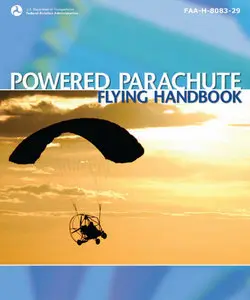Powered Parachute Flying Handbook
U.S. Department of Transportation, Federal Aviation Administration, Airmen Testing Standards Branch
FAA | 2007 | ISBN: n/a | 161 pages | PDF | 15 MB
U.S. Department of Transportation, Federal Aviation Administration, Airmen Testing Standards Branch
FAA | 2007 | ISBN: n/a | 161 pages | PDF | 15 MB
This Handbook is designed as a technical manual for applicants who are preparing for a powered parachute category rating and for currently certificated powered parachute pilots who wish to improve their knowledge. Certificated flight instructors will find this handbook a valuable training aid, since detailed coverage of emergency procedures, components and systems, aerodynamics, powerplants, ground operations, flight maneuvers, airport operations, and aeronautical decision making is included.
This handbook conforms to pilot training and certification concepts established by the FAA.
Contents
Chapter 1—Introduction to the Powered
Parachute
History of the Powered Parachute
Powered Parachute Terms
Introduction to the Powered Parachute
Powered Parachute Pilot Certificate
Eligibility Requirements
Aeronautical Decision Making (ADM)
Resource Management
Use of Checklists
Situational Awareness
Stress Management
Medical Factors Related to the PPC
Alcohol
Anxiety
Carbon Monoxide Poisoning
Dehydration
Drugs
Middle Ear and Sinus Problems
Fatigue
Hyperventilation
Hypoxia
Motion Sickness
Scuba Diving
Spatial Disorientation
Stress
Stroke and Heart Attack
Medical Summary
“The Bottom Line”
Chapter 2—Aerodynamics of Flight
Aerodynamic Terms
Powered Parachute Wing Pressurization
and Flexibility
Forces in Flight
Lift
Drag
Weight
Thrust
Center of Gravity
Axes of Rotation
Ground Effect
Moments
Thrust Line Moments
Gravity Moment
Wing Attachment to Cart
Stability
PPC Angle of Attack Characteristics
Normal Flying Conditions
Flaring Increases Angle of Attack
Porpoising Creates Variations in AOA
Stalls: Exceeding the Critical Angle of Attack
Turning Effect
Weight, Load and Speed Changes
PPC Aerodynamics Summary
Chapter 3—Components and Systems
The Airframe
Center of Gravity Adjustments
Multiple Attachment Points Bracket
Center of Gravity Adjuster Tubes
Instrument Panel
Additional Equipment
Electrical System
The Steering Bars
Wings and Components
Risers
The Fuel Tank
Throttle System
The Powerplant
The Propeller
Axle and Wheel Assembly
Chapter 4—Powerplants
Reciprocating Engines
Two-Stroke Engines
Two-Stroke Process
Four-Stroke Engines
Exhaust Systems
Two-Stroke Tuned Exhaust Systems
Four-Stroke Engine Exhaust Systems
Two-Stroke Engine Warming
Four-Stroke Engine Warming
Gearboxes
Certrifugal Clutch
Propeller
Fixed-Pitch Propeller
Ground Adjustable-Pitch Propeller
Induction Systems
Carburetor Systems
Two-Stroke Carburetor Jetting
Four-Stroke Mixture Settings
Carburetor Icing
Fuel Injection Systems
Ignition System
Combustion
Fuel Systems
Fuel Pumps
Fuel Plunger Primer
Choke
Fuel Bulb Primer
Fuel Gauges
Fuel Filter
Fuel
Fuel Contamination
Bad Gasoline
Refueling Procedures
Mixing Two-Stroke Oil and Fuel
Starting System
Oil Systems
Engine Cooling Systems
Chapter 5—Preflight and Ground Operations
Get Ready to Fly
Trailering
Where to Fly
Weather
Weight and Loading
The Preflight Checklist
Certificates and Documents
Visual Inspection
Cart Inspection
Fuel and Oil
Powerplant Inspection
Engine Starting
EngineWarm-Up
Taxiing
Wing Inspection
Line Tangles, Twists, and Line-Overs
Line Twists
Line-Overs
Preparing for Takeoff
After Landing
Clearing the Runway
Parking
Postflight
Packing theWing
Chapter 6—Basic Flight Maneuvers
The Four Fundamentals
Flight Controls
Throttle
Claring Turns
Turning the Powered Parachute
Feel of the PPC
Attitude Flying
Straight-and Level Flight
Level Turns
Climbing and Climbing Turns, Descents and Descending Turns
Gliding
Wing Trim
Chapter 7—Takeoffs and Departure Climbs
Terms and Definitions
Laying Out theWing
The Inverted Method
The Stacked (or Accordion) Method
Cockpit Management
Before Takeoff Check
Start the Engine/Initial Rollout
Wing Inflation and Kiting
Normal Takeoff
Takeoff Roll
Rotation
Lift-Off
Initial Climb
Centering theWing
Encourage Cell Openings
“Lock-out” Avoidance
Crosswind Takeoff
Positioning the Cart
Wing Inflation and Kiting
Takeoff Roll
Lift-Off
Initial Climb
Rejected Takeoff/Engine Failure
Runway Surface and Gradient
Takeoff Performance
Noise Abatement
Chapter 8—Airspace Classification and Requirements
Controlled Airspace
Class A Airspace
Class B Airspace
Class C Airspace
Class D Airspace
Class E Airspace
Uncontrolled Airspace: Class G
Airspace
Special Use Airspace
Prohibited Areas
Restricted Areas
Warning Areas
Military Operation Areas
Alert Areas
Controlled Firing Areas
Other Airspace Areas
Airport Advisory Areas
Military Training Routes
Temporary Flight Restrictions
Parachute Jump Areas
Published VFR Routes
Terminal Radar Service Areas
National Security Areas
Flight Over Charted U.S. Wildlife Refuges, Parks, and Forest Service Areas
Powered Parachute Operations
PPC and Air Traffic Control
Navigating the Airspace
Chapter 9—Ground Reference Maneuvers
Purpose and Scope
Maneuvering by Reference to
Ground Objects
Drift and Ground Track Control
Rectangular Course
S-Turns Across a Road
Turns Around a Point
Chapter 10—Airport Traffic Patterns
Airport Traffic Patterns and
Operations
Standard Airport Traffic Patterns
Chapter 11—Approaches and Landings
Normal Approach and Landing
Base Leg
Final Approach
Estimating Height and Movement
Roundout
Wing Control
Touchdown
After-Landing Roll
Stabilized Approach Concept
Go-Arounds (Rejected Landings)
Turbulent Air Approach and Landing
Emergency Approach and Landings
(Simulated)
Faulty Approaches and Landings
Low Final Approach
High Final Approach
Use of Power
High Roundout
Bouncing During Touchdown
Hard Landing
Wing Blowing Over After Touchdown
Chapter 12—Night, Abnormal, and Emergency Procedures
Night Operations and the Powered
Parachute
Emergency Situations
Accidents
Potential Hazards of the Standing PPC
Restricted Lines During the Takeoff Roll
Entangled or Embedded Lines
Lines Caught Under a Wheel
A Wing Wall
A Wing Lock-Out
Wing Not Centered Overhead
The Cart Turns Over (Roll-Over)
Engine Failure on Climbout
Engine Failure in Flight
Engine Failure in a PPCL
In-Flight Fire
Landing Porpoise
Gust-Induced Oscillations
Cross-Country Flights
Emergency Equipment and Survival Gear
Glossary
Index
with TOC BookMarkLinks



